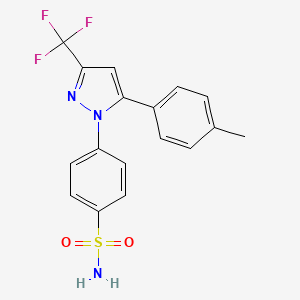Drug Information
Drug (ID: DG00615) and It's Reported Resistant Information
| Name |
Celecoxib
|
||||
|---|---|---|---|---|---|
| Synonyms |
Celecoxib; 169590-42-5; Celebrex; Celebra; Onsenal; Celocoxib; Celecox; SC 58635; 4-[5-(4-METHYLPHENYL)-3-(TRIFLUOROMETHYL)-1H-PYRAZOL-1-YL]BENZENESULFONAMIDE; SC-58635; YM177; 4-[5-(4-methylphenyl)-3-(trifluoromethyl)pyrazol-1-yl]benzenesulfonamide; 184007-95-2; YM 177; C17H14F3N3O2S; HSDB 7038; UNII-JCX84Q7J1L; p-(5-p-Tolyl-3-(trifluoromethyl)pyrazol-1-yl)benzenesulfonamide; MFCD00941298; SC58635; 4-[5-(4-methylphenyl)-3-(trifluoromethyl)-1H-pyrazol-1-yl]benzene-1-sulfonamide; 4-(5-(4-Methylphenyl)-3-(trifluoromethyl)-1H-pyrazol-1-yl)benzenesulfonamide; YM-177; CHEMBL118; JCX84Q7J1L; 194044-54-7; CHEBI:41423; 4-(5-(p-tolyl)-3-(trifluoromethyl)-1H-pyrazol-1-yl)benzenesulfonamide; NSC-719627; NSC-758624; NCGC00091455-01; Xilebao; DSSTox_CID_2777; 4-[5-(4-methylphenyl)-3-(trifluoromethyl)-1H-pyrazol-1-yl]-benzenesulfonamide; 4-[5-(4-methylphenyl)-3-(trifluoromethyl)pyrazol-1-yl]benzenesulfonami de; benzenesulfonamide, 4-[5-(4-methylphenyl)-3-(trifluoromethyl)-1H-pyrazol-1-yl]-; DSSTox_RID_76725; DSSTox_GSID_22777; Solexa; Benzenesulfonamide, 4-(5-(4-methylphenyl)-3-(trifluoromethyl)-1H-pyrazol-1-yl)-; Celebrex (TN); SMR000550473; CAS-169590-42-5; SR-01000837528; Celecoxibum; Celecoxib [USAN:INN:BAN]; CCRIS 9330; TPI-336; Celecoxib- Bio-X; Celecoxib-[d4]; Onsenal (TN); AI-525; CEP-33222; CELEBCOXIB; Spectrum_000432; 1oq5; Spectrum2_001576; Spectrum3_001996; Spectrum4_000182; Spectrum5_001324; cid_2662; SCHEMBL3708; Celecoxib (JAN/USP/INN); DFN15; BSPBio_003596; KBioGR_000723; KBioGR_002351; KBioSS_000912; KBioSS_002354; MLS001165684; MLS001195656; MLS001304708; MLS006011862; BIDD:GT0408; DivK1c_000893; SPECTRUM1503678; SPBio_001512; DFN-15; GTPL2892; Celecoxib, >=98% (HPLC); DTXSID0022777; BDBM11639; HMS502M15; KBio1_000893; KBio2_000912; KBio2_002351; KBio2_003480; KBio2_004919; KBio2_006048; KBio2_007487; KBio3_002830; KBio3_003037; EX-A175; SYN3015; cMAP_000027; NINDS_000893; BCPP000290; Elyxyb (DFN-15; oral solution); HMS1922G14; HMS2089L18; HMS2093I07; HMS2234N18; HMS3259L08; HMS3261A14; HMS3373A09; HMS3654H09; HMS3715F11; HMS3867I03; HMS3884M07; Pharmakon1600-01503678; ACT02648; ALBB-033772; BCP02156; ZINC2570895; Tox21_111135; Tox21_201964; Tox21_300599; Tox21_500406; US8741944, Comparative Compound; 4-[5-(p-tolyl)-3-(trifluoromethyl)pyrazol-1-yl]benzenesulfonamide; BBL029086; CCG-39354; NSC719627; NSC758624; s1261; STL373576; Celecoxib 1.0 mg/ml in Acetonitrile; AKOS015842517; Tox21_111135_1; AC-4228; AM84588; BCP9000507; CS-0570; DB00482; KS-1041; MCULE-4750749400; NC00708; NSC 719627; NSC 758624; SB19318; IDI1_000893; NCGC00091455-02; NCGC00091455-03; NCGC00091455-04; NCGC00091455-05; NCGC00091455-06; NCGC00091455-07; NCGC00091455-08; NCGC00091455-09; NCGC00091455-13; NCGC00254540-01; NCGC00259513-01; NCGC00261091-01; BC164295; BP-30217; HY-14398; NCI60_041049; PHA-00846533; SY064976; SBI-0051875.P002; CJ-016377; CP-598107; UNM-0000305813; FT-0601628; FT-0623536; FT-0700357; SW199611-3; PF-00345549; A25046; C07589; D00567; J10035; AB00052396-07; AB00052396-08; AB00052396-09; AB00052396_10; AB00052396_11; 590C425; Q408801; J-010566; J-520011; Q-200816; SR-01000837528-2; SR-01000837528-3; BRD-K02637541-001-02-4; BRD-K02637541-001-06-5; Z2210694606; Celecoxib, European Pharmacopoeia (EP) Reference Standard; Celecoxib, United States Pharmacopeia (USP) Reference Standard; 4-[5-(p-Tolyl)-3-(trifluoromethyl)-1-pyrazolyl]benzenesulfonamide; 4-(5-p-tolyl-3-(trifluoromethyl)-1H-pyrazol-1-yl)benzenesulfonamide; 4-[5-(4-Methylphenyl)-3-(trifluoromethyl)-pyrazol-1-yl]benzenesulfonamide; 5-(4-Methylphenyl)-1-(4-sulfamoylphenyl)-3-(trifluoromethyl)pyrazole; Celecoxib, Pharmaceutical Secondary Standard; Certified Reference Material; 4-[5-(4-methylphenyl)-3-(trifluoromethyl)-1H-pyazol-1-yl]benezenesulfonamide; Benzenesulfonamide,4-[5-(4-methylphenyl)-3-(trifluoromethyl)-1H-pyrazol-1-yl]-; 4-[5-(4-Methylphenyl)-3-(trifluoromethyl)-pyrazol-1-yl]benzenesulfonamide;4-[5-(4-Methylphenyl)-3-(trifluoromethyl)-1H-pyrazol-1-yl]benzenesulfonamide
Click to Show/Hide
|
||||
| Indication |
In total 2 Indication(s)
|
||||
| Structure |

|
||||
| Drug Resistance Disease(s) |
Disease(s) with Clinically Reported Resistance for This Drug
(2 diseases)
[2]
[1]
|
||||
| Target | Prostaglandin G/H synthase 2 (COX-2) | PGH2_HUMAN | [3] | ||
| Click to Show/Hide the Molecular Information and External Link(s) of This Drug | |||||
| Formula |
C17H14F3N3O2S
|
||||
| IsoSMILES |
CC1=CC=C(C=C1)C2=CC(=NN2C3=CC=C(C=C3)S(=O)(=O)N)C(F)(F)F
|
||||
| InChI |
1S/C17H14F3N3O2S/c1-11-2-4-12(5-3-11)15-10-16(17(18,19)20)22-23(15)13-6-8-14(9-7-13)26(21,24)25/h2-10H,1H3,(H2,21,24,25)
|
||||
| InChIKey |
RZEKVGVHFLEQIL-UHFFFAOYSA-N
|
||||
| PubChem CID | |||||
| ChEBI ID | |||||
| TTD Drug ID | |||||
| VARIDT ID | |||||
| INTEDE ID | |||||
| DrugBank ID | |||||
Type(s) of Resistant Mechanism of This Drug
Drug Resistance Data Categorized by Their Corresponding Diseases
ICD-02: Benign/in-situ/malignant neoplasm
| Drug Sensitivity Data Categorized by Their Corresponding Mechanisms | ||||
|
|
||||
| Key Molecule: Prostaglandin G/H synthase 2 (PTGS2) | [3] | |||
| Molecule Alteration | Expression | Down-regulation |
||
| Sensitive Disease | Glioblastoma [ICD-11: 2A00.02] | |||
| Experimental Note | Revealed Based on the Cell Line Data | |||
| Cell Pathway Regulation | Cell proliferation | Inhibition | hsa05200 | |
| Cell apoptosis | Activation | hsa04210 | ||
| Cell autophagy | Activation | hsa04140 | ||
| In Vitro Model | MDA-175 cells | Pleural effusion | Homo sapiens (Human) | CVCL_1400 |
| MMQ cells | Pituitary gland | Rattus norvegicus (Rat) | CVCL_2117 | |
| Experiment for Molecule Alteration |
Western blot analysis; Fluorescence microscopy assay | |||
| Experiment for Drug Resistance |
MTS assay; Crystal violet staining assay; Fluorescence-activated cell sorting (FACS) assay; Flow cytometry | |||
| Mechanism Description | Celecoxib reverses the glioblastoma chemo-resistance to temozolomide through mitochondrial metabolism. | |||
ICD-15: Musculoskeletal/connective-tissue diseases
| Drug Resistance Data Categorized by Their Corresponding Mechanisms | ||||
|
|
||||
| Key Molecule: ATP-binding cassette sub-family G2 (ABCG2) | [1] | |||
| Molecule Alteration | Expression | Up-regulation |
||
| Resistant Disease | Rheumatoid arthritis [ICD-11: FA20.0] | |||
| Experimental Note | Identified from the Human Clinical Data | |||
| Mechanism Description | MTX is a substrate for eight ABC transporters. In vitro studies demonstrated that RAFLS treated with MTX had higher ABCB1 expression levels than controls, with a positive correlation between ABCB1 expression levels and RA treatment duration. In addition to MTX, other DMARDs (e.g. sulfasalazine, leflunomide, bucillamine, azathioprine), glucocorticoids (e.g. betamethasone, dexamethasone), and NSAIDs (e.g. celecoxib and indomethacin) are also substrates of ABC transporters. | |||
ICD-16: Genitourinary system diseases
| Drug Resistance Data Categorized by Their Corresponding Mechanisms | ||||
|
|
||||
| Key Molecule: Cytochrome P450 family 2 subfamily C member 9 (CYP2C9) | [2] | |||
| Molecule Alteration | SNP | CYP2C9*2/*2 |
||
| Resistant Disease | Dysmenorrhea [ICD-11: GA34.3] | |||
| Experimental Note | Identified from the Human Clinical Data | |||
| Mechanism Description | For example, the CYP2C9*2/*2 polymorphism was associated with increased total clearance of celecoxib and diclofenac.48 More research is necessary to determine if other gain-of-function variants exist and alter NSAID metabolism. | |||
References
If you find any error in data or bug in web service, please kindly report it to Dr. Sun and Dr. Zhang.
